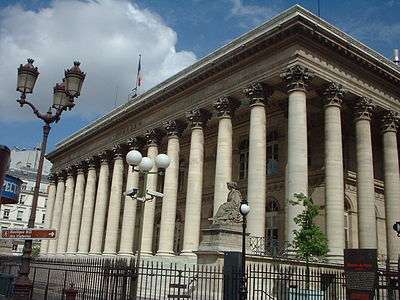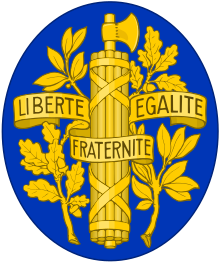Euronext Paris
Euronext Paris is France's securities market, formerly known as the Paris Bourse, which merged with the Amsterdam, Lisbon, and Brussels exchanges in September 2000 to form Euronext NV, which is the second largest exchange in Europe behind the United Kingdom's London Stock Exchange Group.
 | |
 | |
| Type | Stock exchange |
|---|---|
| Location | Paris, France |
| Founded | 1724 (as Paris Bourse) 2000 (as Euronext Paris) |
| Owner | Euronext |
| Key people | Anthony Attia (CEO) |
| Currency | EUR |
| No. of listings | 1,078[1] |
| Indices | CAC 40 CAC Next 20 CAC Mid 60 CAC Small |
| Website | www |
Operations
It operates the MATIF futures exchange, which trades futures and options on interest rate products and commodities, and MONEP, equity and index futures and options. All products are traded electronically on the NSC system adopted by all of the Euronext members. Transactions are cleared through LCH.Clearnet. Cash settlement is T+2.[2] Trading hours are 9 am to 5:30 pm CET, Monday to Friday.
Structure and indices
The French equities market is divided into three sections. The Premier Marché, formerly called the Official List, includes large French and foreign companies, and most Bond issues. The Second Marché, lists medium-sized companies, while nouveau marché lists fast-growing start up companies seeking capital to finance expansion, linked to Euro.nm, the European equity growth market. A fourth market, Marché Libre, is nonregulated, administered by Euronext Paris for transactions in securities not listed on the other three markets.
Euronext Paris calculates a family of indices. The CAC 40 is the exchange's benchmark, disseminated in real time. Its components are included in the broader SBF 120 Index, a benchmark for investment funds. The SBF 250 index, a benchmark for the long-term performance of equity portfolios, includes all of the SBF 120; it is structured by sector. The MIDCAC index includes 100 of the most liquid medium-size stocks on the Premier Marché and Nouveau Marché calculated on the basis of opening and closing prices, while the Second Marché index focuses on that market. Both indices are benchmarks for funds. The Nouveau Marché Index represents stocks in the growth market. The SBF-FCI index is based on a selection of convertible bonds that represent at least 70% of the total capitalization of this market, calculated twice daily. For derivatives, MONEP trades short-term and long-term stock options and futures and options on a family of Dow Jones indices. MATIF's products include commodity future and options on European rapeseed and futures on rapeseed meal, European rapeseed oil, milling wheat, corn and sunflower seeds; interest rate futures and options on the Euro notional bond, five-year Euro and three-month PIBOR (Paris Interbank Offered Rate), and futures on the 30-year Eurobond and two-year E-note, and index futures on the CAC 40.
Key figures
For the fiscal year ending December 2004, Euronext Paris recorded sales of US $522 million, a −12.9% decrease in sales from 2003.
Euronext Paris has a US $2.9 trillion total market capitalization of listed companies and average daily trading value of its combined markets of approximately US $102 billion/€77 billion (as of 28 February 2007).
See also
- List of French companies
- CAC 40
- CAC Next 20
- French Society of Financial Analysts
References
- "Cours, Bourse de Paris". Euronext. Retrieved 1 January 2016.
- "T+2 Standard settlement Lifecycle update". Euronext. 28 July 2014. Retrieved 28 February 2015.
